-
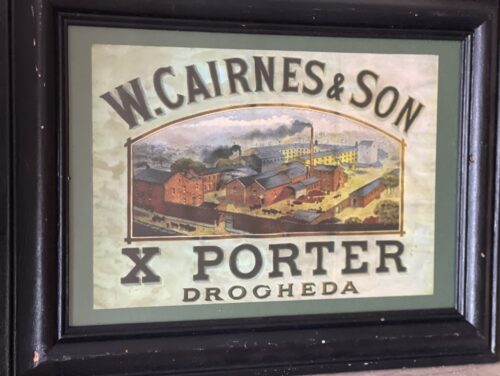
 38cm x 30cm Drogheda W.Cairnes & Son Ltd, Drogheda, Co Louth, Ireland. Founded 1828 by William Cairnes. Registered April 1890 as the Castlebellingham & Drogheda Breweries Ltd. to acquire John Woolsey & Co. Ltd, Castlebellingham and William Cairnes & Son. Name changed as above in November 1933. Acquired by Guinness and ceased brewing in October 1959. From the Brewery History Society Journal Number 91 Founded in 1828 by William Cairnes with good markets in both Dublin and Belfast. In 1850 they extended their malt liquor portfolio to include porter. The brewery was closed in 1959 as part of a rationalisation plan when the Cherry-Cairnes partnership was dissolved, to be subsequently replaced by the Irish Ale Breweries Group, (a Guinness/Allied Breweries combination). Irish Ale Breweries was formally dissolved in 1988, becoming Guinness Ireland.
38cm x 30cm Drogheda W.Cairnes & Son Ltd, Drogheda, Co Louth, Ireland. Founded 1828 by William Cairnes. Registered April 1890 as the Castlebellingham & Drogheda Breweries Ltd. to acquire John Woolsey & Co. Ltd, Castlebellingham and William Cairnes & Son. Name changed as above in November 1933. Acquired by Guinness and ceased brewing in October 1959. From the Brewery History Society Journal Number 91 Founded in 1828 by William Cairnes with good markets in both Dublin and Belfast. In 1850 they extended their malt liquor portfolio to include porter. The brewery was closed in 1959 as part of a rationalisation plan when the Cherry-Cairnes partnership was dissolved, to be subsequently replaced by the Irish Ale Breweries Group, (a Guinness/Allied Breweries combination). Irish Ale Breweries was formally dissolved in 1988, becoming Guinness Ireland. -
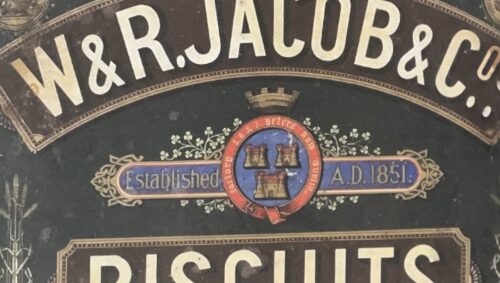
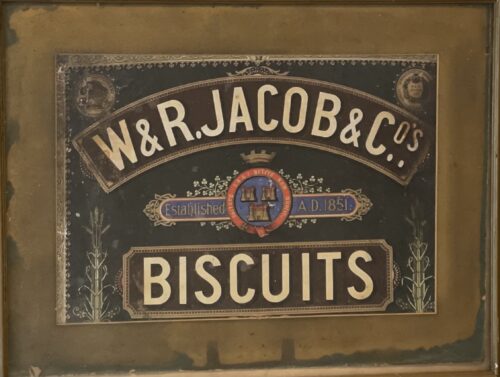 42cm x 32cm Limerick The Jacobs Biscuit Bakery originated in Waterford in 1851,after being founded by William Beale Jacob and his brother Robert.It later moved to Bishop Street in Dublin with a further factory in Peters Row.Jacobs Bishop Street premises was occupied as a strategic location by rebels during the 1916 Easter Rebellion. W. & R. Jacob's were one the largest employers in the Dublin of 1916, and their factory was seized on Easter Monday by perhaps 100 members of the 2nd Battalion of the Dublin Brigade of the Irish Volunteers under Thomas MacDonagh. The factory itself was an enormous and formidable Victorian edifice located on the 'block' enclosed by Bishop St, Bride St, Peter's St and Peter's Row, and between St Patrick's Cathedral and St Stephen's Green. Its seizure helped to complete a loop of building cross the south inner city; the factory had two large towers that could act as observation points, while its location was very close to both Camden St and Patrick St: natural routeways for troops entering the city centre from Portobello Barracks in Rathmines and Wellington Barracks on the South Circular Road. There were only a few staff present in the building when the Volunteers broke into it; a number of smaller outposts were established in the area around the factory. While the garrison saw some fighting early in the week, their principal enemies proved to be boredom and the locals: the factory was surrounded by tenements, and the Volunteers were attacked and abused by residents, many of whom were Jacob's workers themselves. The families of servicemen were also quite hostile, but there may have been another reason for this hostility: Michael O'Hanrahan, who was in Jacob's, expressed his concern that the choice of location might endanger local residents if the British chose to attack. As it happens, the factory was largely by-passed, though it was fired upon intermittently throughout the week by troops in Dublin Castle and elsewhere. MacDonagh surrendered in nearby St Patrick's Park on Sunday 30 April; some of the factory was looted after the Volunteers had left. Three members of the Jacob's garrison were executed. Most of the factory was eventually demolished, though fragments of the ground storey and one of the towers are still visible on Bishop St between the DIT campus on Aungier St and the National Archives of Ireland.
42cm x 32cm Limerick The Jacobs Biscuit Bakery originated in Waterford in 1851,after being founded by William Beale Jacob and his brother Robert.It later moved to Bishop Street in Dublin with a further factory in Peters Row.Jacobs Bishop Street premises was occupied as a strategic location by rebels during the 1916 Easter Rebellion. W. & R. Jacob's were one the largest employers in the Dublin of 1916, and their factory was seized on Easter Monday by perhaps 100 members of the 2nd Battalion of the Dublin Brigade of the Irish Volunteers under Thomas MacDonagh. The factory itself was an enormous and formidable Victorian edifice located on the 'block' enclosed by Bishop St, Bride St, Peter's St and Peter's Row, and between St Patrick's Cathedral and St Stephen's Green. Its seizure helped to complete a loop of building cross the south inner city; the factory had two large towers that could act as observation points, while its location was very close to both Camden St and Patrick St: natural routeways for troops entering the city centre from Portobello Barracks in Rathmines and Wellington Barracks on the South Circular Road. There were only a few staff present in the building when the Volunteers broke into it; a number of smaller outposts were established in the area around the factory. While the garrison saw some fighting early in the week, their principal enemies proved to be boredom and the locals: the factory was surrounded by tenements, and the Volunteers were attacked and abused by residents, many of whom were Jacob's workers themselves. The families of servicemen were also quite hostile, but there may have been another reason for this hostility: Michael O'Hanrahan, who was in Jacob's, expressed his concern that the choice of location might endanger local residents if the British chose to attack. As it happens, the factory was largely by-passed, though it was fired upon intermittently throughout the week by troops in Dublin Castle and elsewhere. MacDonagh surrendered in nearby St Patrick's Park on Sunday 30 April; some of the factory was looted after the Volunteers had left. Three members of the Jacob's garrison were executed. Most of the factory was eventually demolished, though fragments of the ground storey and one of the towers are still visible on Bishop St between the DIT campus on Aungier St and the National Archives of Ireland. -
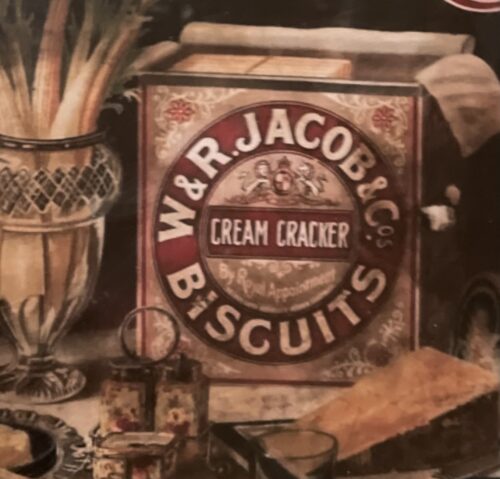
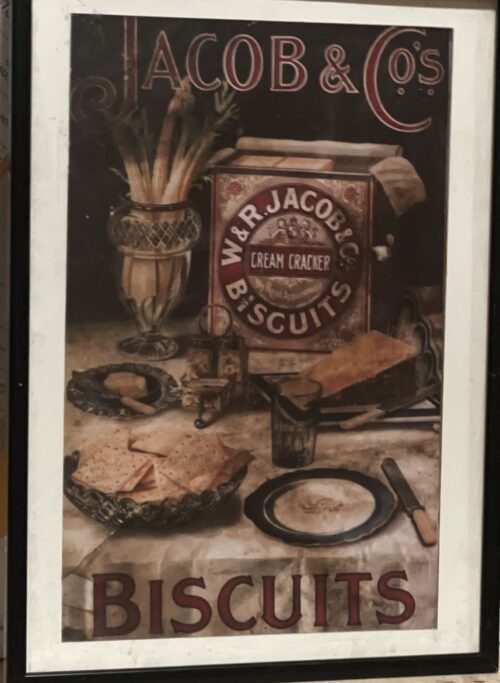 46cm x 39cm Limerick The Jacobs Biscuit Bakery originated in Waterford in 1851,after being founded by William Beale Jacob and his brother Robert.It later moved to Bishop Street in Dublin with a further factory in Peters Row.Jacobs Bishop Street premises was occupied as a strategic location by rebels during the 1916 Easter Rebellion. W. & R. Jacob's were one the largest employers in the Dublin of 1916, and their factory was seized on Easter Monday by perhaps 100 members of the 2nd Battalion of the Dublin Brigade of the Irish Volunteers under Thomas MacDonagh. The factory itself was an enormous and formidable Victorian edifice located on the 'block' enclosed by Bishop St, Bride St, Peter's St and Peter's Row, and between St Patrick's Cathedral and St Stephen's Green. Its seizure helped to complete a loop of building cross the south inner city; the factory had two large towers that could act as observation points, while its location was very close to both Camden St and Patrick St: natural routeways for troops entering the city centre from Portobello Barracks in Rathmines and Wellington Barracks on the South Circular Road. There were only a few staff present in the building when the Volunteers broke into it; a number of smaller outposts were established in the area around the factory. While the garrison saw some fighting early in the week, their principal enemies proved to be boredom and the locals: the factory was surrounded by tenements, and the Volunteers were attacked and abused by residents, many of whom were Jacob's workers themselves. The families of servicemen were also quite hostile, but there may have been another reason for this hostility: Michael O'Hanrahan, who was in Jacob's, expressed his concern that the choice of location might endanger local residents if the British chose to attack. As it happens, the factory was largely by-passed, though it was fired upon intermittently throughout the week by troops in Dublin Castle and elsewhere. MacDonagh surrendered in nearby St Patrick's Park on Sunday 30 April; some of the factory was looted after the Volunteers had left. Three members of the Jacob's garrison were executed. Most of the factory was eventually demolished, though fragments of the ground storey and one of the towers are still visible on Bishop St between the DIT campus on Aungier St and the National Archives of Ireland.
46cm x 39cm Limerick The Jacobs Biscuit Bakery originated in Waterford in 1851,after being founded by William Beale Jacob and his brother Robert.It later moved to Bishop Street in Dublin with a further factory in Peters Row.Jacobs Bishop Street premises was occupied as a strategic location by rebels during the 1916 Easter Rebellion. W. & R. Jacob's were one the largest employers in the Dublin of 1916, and their factory was seized on Easter Monday by perhaps 100 members of the 2nd Battalion of the Dublin Brigade of the Irish Volunteers under Thomas MacDonagh. The factory itself was an enormous and formidable Victorian edifice located on the 'block' enclosed by Bishop St, Bride St, Peter's St and Peter's Row, and between St Patrick's Cathedral and St Stephen's Green. Its seizure helped to complete a loop of building cross the south inner city; the factory had two large towers that could act as observation points, while its location was very close to both Camden St and Patrick St: natural routeways for troops entering the city centre from Portobello Barracks in Rathmines and Wellington Barracks on the South Circular Road. There were only a few staff present in the building when the Volunteers broke into it; a number of smaller outposts were established in the area around the factory. While the garrison saw some fighting early in the week, their principal enemies proved to be boredom and the locals: the factory was surrounded by tenements, and the Volunteers were attacked and abused by residents, many of whom were Jacob's workers themselves. The families of servicemen were also quite hostile, but there may have been another reason for this hostility: Michael O'Hanrahan, who was in Jacob's, expressed his concern that the choice of location might endanger local residents if the British chose to attack. As it happens, the factory was largely by-passed, though it was fired upon intermittently throughout the week by troops in Dublin Castle and elsewhere. MacDonagh surrendered in nearby St Patrick's Park on Sunday 30 April; some of the factory was looted after the Volunteers had left. Three members of the Jacob's garrison were executed. Most of the factory was eventually demolished, though fragments of the ground storey and one of the towers are still visible on Bishop St between the DIT campus on Aungier St and the National Archives of Ireland. -

 42cm x 32cm Limerick The Jacobs Biscuit Bakery originated in Waterford in 1851,after being founded by William Beale Jacob and his brother Robert.It later moved to Bishop Street in Dublin with a further factory in Peters Row.Jacobs Bishop Street premises was occupied as a strategic location by rebels during the 1916 Easter Rebellion. W. & R. Jacob's were one the largest employers in the Dublin of 1916, and their factory was seized on Easter Monday by perhaps 100 members of the 2nd Battalion of the Dublin Brigade of the Irish Volunteers under Thomas MacDonagh. The factory itself was an enormous and formidable Victorian edifice located on the 'block' enclosed by Bishop St, Bride St, Peter's St and Peter's Row, and between St Patrick's Cathedral and St Stephen's Green. Its seizure helped to complete a loop of building cross the south inner city; the factory had two large towers that could act as observation points, while its location was very close to both Camden St and Patrick St: natural routeways for troops entering the city centre from Portobello Barracks in Rathmines and Wellington Barracks on the South Circular Road. There were only a few staff present in the building when the Volunteers broke into it; a number of smaller outposts were established in the area around the factory. While the garrison saw some fighting early in the week, their principal enemies proved to be boredom and the locals: the factory was surrounded by tenements, and the Volunteers were attacked and abused by residents, many of whom were Jacob's workers themselves. The families of servicemen were also quite hostile, but there may have been another reason for this hostility: Michael O'Hanrahan, who was in Jacob's, expressed his concern that the choice of location might endanger local residents if the British chose to attack. As it happens, the factory was largely by-passed, though it was fired upon intermittently throughout the week by troops in Dublin Castle and elsewhere. MacDonagh surrendered in nearby St Patrick's Park on Sunday 30 April; some of the factory was looted after the Volunteers had left. Three members of the Jacob's garrison were executed. Most of the factory was eventually demolished, though fragments of the ground storey and one of the towers are still visible on Bishop St between the DIT campus on Aungier St and the National Archives of Ireland.
42cm x 32cm Limerick The Jacobs Biscuit Bakery originated in Waterford in 1851,after being founded by William Beale Jacob and his brother Robert.It later moved to Bishop Street in Dublin with a further factory in Peters Row.Jacobs Bishop Street premises was occupied as a strategic location by rebels during the 1916 Easter Rebellion. W. & R. Jacob's were one the largest employers in the Dublin of 1916, and their factory was seized on Easter Monday by perhaps 100 members of the 2nd Battalion of the Dublin Brigade of the Irish Volunteers under Thomas MacDonagh. The factory itself was an enormous and formidable Victorian edifice located on the 'block' enclosed by Bishop St, Bride St, Peter's St and Peter's Row, and between St Patrick's Cathedral and St Stephen's Green. Its seizure helped to complete a loop of building cross the south inner city; the factory had two large towers that could act as observation points, while its location was very close to both Camden St and Patrick St: natural routeways for troops entering the city centre from Portobello Barracks in Rathmines and Wellington Barracks on the South Circular Road. There were only a few staff present in the building when the Volunteers broke into it; a number of smaller outposts were established in the area around the factory. While the garrison saw some fighting early in the week, their principal enemies proved to be boredom and the locals: the factory was surrounded by tenements, and the Volunteers were attacked and abused by residents, many of whom were Jacob's workers themselves. The families of servicemen were also quite hostile, but there may have been another reason for this hostility: Michael O'Hanrahan, who was in Jacob's, expressed his concern that the choice of location might endanger local residents if the British chose to attack. As it happens, the factory was largely by-passed, though it was fired upon intermittently throughout the week by troops in Dublin Castle and elsewhere. MacDonagh surrendered in nearby St Patrick's Park on Sunday 30 April; some of the factory was looted after the Volunteers had left. Three members of the Jacob's garrison were executed. Most of the factory was eventually demolished, though fragments of the ground storey and one of the towers are still visible on Bishop St between the DIT campus on Aungier St and the National Archives of Ireland. -

 44cm x 34cm Dublin The Marrowbone Lane Distillery was an Irish whiskey distillery located on Marrowbone Lane, in Dublin, Ireland. One of the "big four" historical Dublin whiskey firms, it was run by William Jameson, a member of the Jameson whiskey dynasty. However, the whiskey now known as Jameson Irish Whiskey was not produced at this distillery, but at the separate enterprise run by John Jameson at the nearby Bow Street Distillery. The distillery closed in 1923 following financial difficulties.The precise origins of the distillery are uncertain, however, it was likely established in the 1750s (possibly 1752) and later acquired by the Stein family, relatives of the Jameson family circa 1780. An excise return in 1802 lists Stein and Jameson, however, by 1822 the company had become William Jameson & Co. Initially a small undertaking, with an output of just 30,000 gallons per annum, the distillery expanded over time, and by the time Alfred Barnard, a British historian visited the distillery in the 1880s, it had grown to cover some 14 acres. In his book, The Whisky Distilleries of the United Kingdom, Barnard described Marrowbone Lane as having some of the biggest distilling equipment in the world, including two mash tuns with capacities in excess of 100,000 gallons, which were the "said to be the largest in the United Kingdom". At its peak, the distillery was the second largest in Dublin (then one of the world's largest whiskey distilling centres), with an output of 900,000 gallons per annum, and a staff of 200, including 30 coopers. The whiskey produced at the distillery, known as "Dublin Whiskey" was chiefly exported to Australia, Canada, India and the United States. Later renamed the Dublin Distilling Company, the company entered financial difficulties in the late 1800s, and in 1891, merged with George Roe's Thomas Street Distillery and the Dublin Whiskey Distillery Company's Jones Road Distillery to form the Dublin Distilleries Company Ltd. Although, the amalgamated company had a potential production capacity of 3.5 million gallons per annum, it continued to endure severe financial difficulties, in particular, following the loss of both the American and British Commonwealth export markets during prohibition and the Anglo-Irish trade war in the 1920s. Both the Thomas Street and Marrowbone Lane distilleries closed in 1923, with the Jones Road Distillery following suit in 1926. Though distilling may have continued at Jones Road until 1946. During the 1916 Easter uprising, both the Marrowbone Lane distillery and Roe's distillery at Thomas Street were used as strongpoints by a force of more than a hundred rebels.
44cm x 34cm Dublin The Marrowbone Lane Distillery was an Irish whiskey distillery located on Marrowbone Lane, in Dublin, Ireland. One of the "big four" historical Dublin whiskey firms, it was run by William Jameson, a member of the Jameson whiskey dynasty. However, the whiskey now known as Jameson Irish Whiskey was not produced at this distillery, but at the separate enterprise run by John Jameson at the nearby Bow Street Distillery. The distillery closed in 1923 following financial difficulties.The precise origins of the distillery are uncertain, however, it was likely established in the 1750s (possibly 1752) and later acquired by the Stein family, relatives of the Jameson family circa 1780. An excise return in 1802 lists Stein and Jameson, however, by 1822 the company had become William Jameson & Co. Initially a small undertaking, with an output of just 30,000 gallons per annum, the distillery expanded over time, and by the time Alfred Barnard, a British historian visited the distillery in the 1880s, it had grown to cover some 14 acres. In his book, The Whisky Distilleries of the United Kingdom, Barnard described Marrowbone Lane as having some of the biggest distilling equipment in the world, including two mash tuns with capacities in excess of 100,000 gallons, which were the "said to be the largest in the United Kingdom". At its peak, the distillery was the second largest in Dublin (then one of the world's largest whiskey distilling centres), with an output of 900,000 gallons per annum, and a staff of 200, including 30 coopers. The whiskey produced at the distillery, known as "Dublin Whiskey" was chiefly exported to Australia, Canada, India and the United States. Later renamed the Dublin Distilling Company, the company entered financial difficulties in the late 1800s, and in 1891, merged with George Roe's Thomas Street Distillery and the Dublin Whiskey Distillery Company's Jones Road Distillery to form the Dublin Distilleries Company Ltd. Although, the amalgamated company had a potential production capacity of 3.5 million gallons per annum, it continued to endure severe financial difficulties, in particular, following the loss of both the American and British Commonwealth export markets during prohibition and the Anglo-Irish trade war in the 1920s. Both the Thomas Street and Marrowbone Lane distilleries closed in 1923, with the Jones Road Distillery following suit in 1926. Though distilling may have continued at Jones Road until 1946. During the 1916 Easter uprising, both the Marrowbone Lane distillery and Roe's distillery at Thomas Street were used as strongpoints by a force of more than a hundred rebels. -

 24cm x 40cm From the double-takes by people currently walking down King’s Inn Street at the doors to Williams and Woods , you might be forgiven for thinking the former confectionary factory is returning in some Willy Wonka spectacular. The building’s distinctive corner sign has snuck it into the city’s collective memory, making it deeply exciting to see boards coming away from the windows and the glazing being repaired. Williams and Woods moved to Great Britain Street (now Parnell Street) in 1875, operating as confectionary manufacturers and wholesalers. The company acquired adjacent sites, including land across Loftus Lane, and had a factory complex that produced sweets, preserves, canned goods and vinegar. (There’s a history of acquisitions – including being bought by Cross and Blackwell in 1928 – that’s a bit involved for our purposes, but it brings in many well-known names such as Chef, Toblerone, Keiller Little Chip, The National Canning Company of Ireland and Silvermints.) This particular part of the factory seems to have been built around 1900, completely destroyed by fire in 1908, and built again by 1910 (a jam factory designed by Donnelly & Moore), though it’s a little difficult to determine which part of the block is referred to in news reports.
24cm x 40cm From the double-takes by people currently walking down King’s Inn Street at the doors to Williams and Woods , you might be forgiven for thinking the former confectionary factory is returning in some Willy Wonka spectacular. The building’s distinctive corner sign has snuck it into the city’s collective memory, making it deeply exciting to see boards coming away from the windows and the glazing being repaired. Williams and Woods moved to Great Britain Street (now Parnell Street) in 1875, operating as confectionary manufacturers and wholesalers. The company acquired adjacent sites, including land across Loftus Lane, and had a factory complex that produced sweets, preserves, canned goods and vinegar. (There’s a history of acquisitions – including being bought by Cross and Blackwell in 1928 – that’s a bit involved for our purposes, but it brings in many well-known names such as Chef, Toblerone, Keiller Little Chip, The National Canning Company of Ireland and Silvermints.) This particular part of the factory seems to have been built around 1900, completely destroyed by fire in 1908, and built again by 1910 (a jam factory designed by Donnelly & Moore), though it’s a little difficult to determine which part of the block is referred to in news reports. -
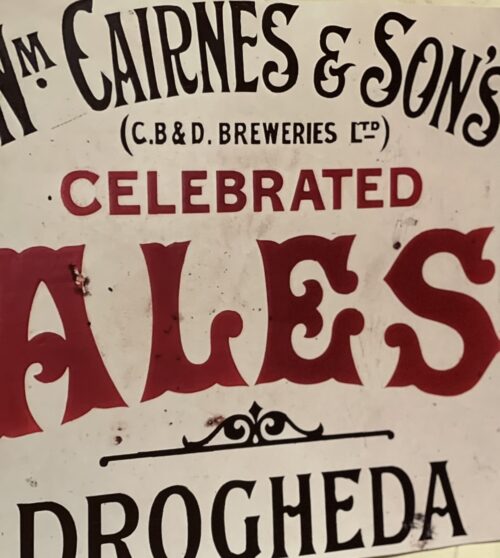
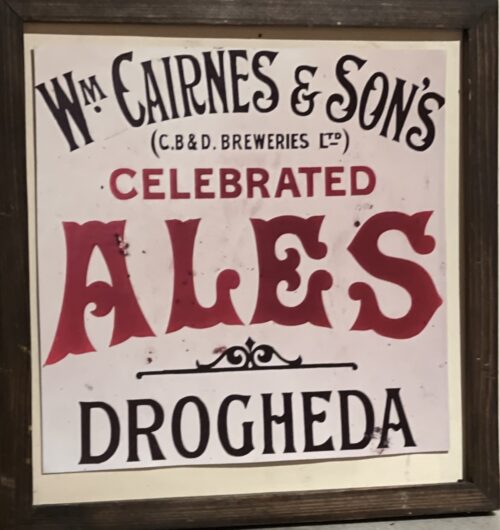 30cm x 30cm ANOTHER great industry on the Scotch Hall site was the brewing firm of Cairnes Ltd, one of the original firms of Irish brewers dating back to 1772 with the foundation of the Castlebellingham Brewery at the picturesque Co Louth village of that name.In 1825, William Cairnes, who was related by marriage to the owners of the ’Bellingham brewery, founded the brewery at Marsh Road, Drogheda, which, for over 150 years, gave employment to almost 200 workers and the firm was famous for its ales and stout. In 1889 the interests of the two breweries were pooled, a public company being formed under the title of the Castlebellingham and Drogheda Breweries Ltd. This title was changed for brevity in 1933 to Cairnes Ltd. For a good many years subsequent to the merger, the breweries were worked independently, each supplying its own customers throughout Ireland and abroad. However, in 1923, it was considered advisable to concentrate brewing in Drogheda, owing to the more advantageous position of the town, and the brewing plant and premises there, were more extensive. Actually the plant at Drogheda was one of the most up-to-date in Ireland and compared very favourably with that of breweries in England and Wales. The supply of brewing water was obtained from a 400ft deep artesian well on the company’s premises. (I wonder if it is still there) and this water was used with the choicest hops and malt made from the best Irish barley obtainable. The hops used came chiefly from Kent and when obtainable, a percentage came from the USA. The process through which the barley went from its arrival in the brewery until it emerged as ale or stout, was extremely interesting and quaint. The barley was first dried to a consistent level of moisture content and then stored for a few weeks before being steeped. It was then ‘floored’ on lots which the brewery had, as well as lofts in Dominic Street and Wellington Quay. These have, in recent years, been converted into shops and a high rise apartment block. Here on these lofts the growing process of the barley in the ground was artificially repeated, the growth however being terminated at the desired stage. The barley was then kilned and cured before being ground and mashed with hot water and the liquid was drawn off. It was then run to built-in coppers, where hops was added, then boiled, the wort, as it was called, being subsequently strained from the hops, cooled and fermented. The final stage was when the beer was casked (in wooden barrels) and matured.
30cm x 30cm ANOTHER great industry on the Scotch Hall site was the brewing firm of Cairnes Ltd, one of the original firms of Irish brewers dating back to 1772 with the foundation of the Castlebellingham Brewery at the picturesque Co Louth village of that name.In 1825, William Cairnes, who was related by marriage to the owners of the ’Bellingham brewery, founded the brewery at Marsh Road, Drogheda, which, for over 150 years, gave employment to almost 200 workers and the firm was famous for its ales and stout. In 1889 the interests of the two breweries were pooled, a public company being formed under the title of the Castlebellingham and Drogheda Breweries Ltd. This title was changed for brevity in 1933 to Cairnes Ltd. For a good many years subsequent to the merger, the breweries were worked independently, each supplying its own customers throughout Ireland and abroad. However, in 1923, it was considered advisable to concentrate brewing in Drogheda, owing to the more advantageous position of the town, and the brewing plant and premises there, were more extensive. Actually the plant at Drogheda was one of the most up-to-date in Ireland and compared very favourably with that of breweries in England and Wales. The supply of brewing water was obtained from a 400ft deep artesian well on the company’s premises. (I wonder if it is still there) and this water was used with the choicest hops and malt made from the best Irish barley obtainable. The hops used came chiefly from Kent and when obtainable, a percentage came from the USA. The process through which the barley went from its arrival in the brewery until it emerged as ale or stout, was extremely interesting and quaint. The barley was first dried to a consistent level of moisture content and then stored for a few weeks before being steeped. It was then ‘floored’ on lots which the brewery had, as well as lofts in Dominic Street and Wellington Quay. These have, in recent years, been converted into shops and a high rise apartment block. Here on these lofts the growing process of the barley in the ground was artificially repeated, the growth however being terminated at the desired stage. The barley was then kilned and cured before being ground and mashed with hot water and the liquid was drawn off. It was then run to built-in coppers, where hops was added, then boiled, the wort, as it was called, being subsequently strained from the hops, cooled and fermented. The final stage was when the beer was casked (in wooden barrels) and matured. -

 50cm x 70cm Drumcondra Dublin Once the Willy Wonka chocolate factory of Dublin,Williams & Woods kept generations of children and adults happy with their large range of confectionary items as advertised in this rare, original print from the late 1890s.The company is long gone but happily the building has been put to good use as you can read below.William's & Woods building on King's Inn Street in Dublin City Centre is where it all began - the first home to the Chocolate Factory shared creative space. Once manufacturing various sweet treats including Toblerone and Mint Crisp, this industrial building now houses an eclectic mix of small businesses and individuals in creative sectors including art, design, music, photography, craft, up-cycling, dance, illustration, graphics, events, horticulture, baking and small batch food & drink production. The incredible transformation and re-invention of Dublin's first concrete building into a creative and collaborative space continues in addition to other alternative Chocolate Factory venues around the country.
50cm x 70cm Drumcondra Dublin Once the Willy Wonka chocolate factory of Dublin,Williams & Woods kept generations of children and adults happy with their large range of confectionary items as advertised in this rare, original print from the late 1890s.The company is long gone but happily the building has been put to good use as you can read below.William's & Woods building on King's Inn Street in Dublin City Centre is where it all began - the first home to the Chocolate Factory shared creative space. Once manufacturing various sweet treats including Toblerone and Mint Crisp, this industrial building now houses an eclectic mix of small businesses and individuals in creative sectors including art, design, music, photography, craft, up-cycling, dance, illustration, graphics, events, horticulture, baking and small batch food & drink production. The incredible transformation and re-invention of Dublin's first concrete building into a creative and collaborative space continues in addition to other alternative Chocolate Factory venues around the country.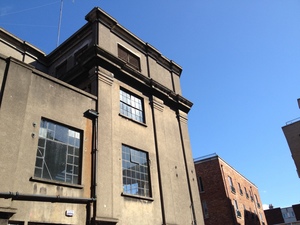
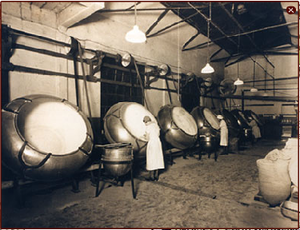
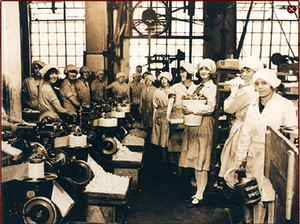
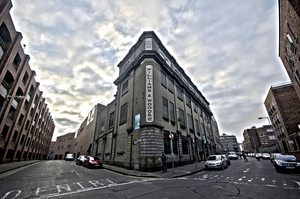 D
D
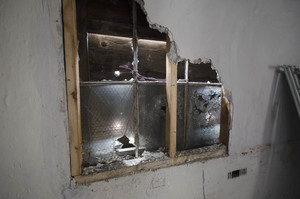
-

 Fantastic vintage W.& R.Jacob & Co.Ltd Biscuit & Cake Manufacturers Dublin Advert depicting the famous Dublin Landmark which played such a pivotal role in the 1916 Easter Rising which altered the course of Irish History forever. Clonsilla Dublin 45.5cm x 57.5cm The biscuit making firm of W. & R. Jacob's were one the largest employers in the Dublin of 1916, and their factory was seized on Easter Monday by perhaps 100 members of the 2nd Battalion of the Dublin Brigade of the Irish Volunteers under Thomas MacDonagh. The factory itself was an enormous and formidable Victorian edifice located on the 'block' enclosed by Bishop St, Bride St, Peter's St and Peter's Row, and between St Patrick's Cathedral and St Stephen's Green. Its seizure helped to complete a loop of building cross the south inner city; the factory had two large towers that could act as observation points, while its location was very close to both Camden St and Patrick St: natural routeways for troops entering the city centre from Portobello Barracks in Rathmines and Wellington Barracks on the South Circular Road. There were only a few staff present in the building when the Volunteers broke into it; a number of smaller outposts were established in the area around the factory. While the garrison saw some fighting early in the week, their principal enemies proved to be boredom and the locals: the factory was surrounded by tenements, and the Volunteers were attacked and abused by residents, many of whom were Jacob's workers themselves. The families of servicemen were also quite hostile, but there may have been another reason for this hostility: Michael O'Hanrahan, who was in Jacob's, expressed his concern that the choice of location might endanger local residents if the British chose to attack. As it happens, the factory was largely by-passed, though it was fired upon intermittently throughout the week by troops in Dublin Castle and elsewhere. MacDonagh surrendered in nearby St Patrick's Park on Sunday 30 April; some of the factory was looted after the Volunteers had left. Three members of the Jacob's garrison were executed. Most of the factory was eventually demolished, though fragments of the ground storey and one of the towers are still visible on Bishop St between the DIT campus on Aungier St and the National Archives of Ireland.
Fantastic vintage W.& R.Jacob & Co.Ltd Biscuit & Cake Manufacturers Dublin Advert depicting the famous Dublin Landmark which played such a pivotal role in the 1916 Easter Rising which altered the course of Irish History forever. Clonsilla Dublin 45.5cm x 57.5cm The biscuit making firm of W. & R. Jacob's were one the largest employers in the Dublin of 1916, and their factory was seized on Easter Monday by perhaps 100 members of the 2nd Battalion of the Dublin Brigade of the Irish Volunteers under Thomas MacDonagh. The factory itself was an enormous and formidable Victorian edifice located on the 'block' enclosed by Bishop St, Bride St, Peter's St and Peter's Row, and between St Patrick's Cathedral and St Stephen's Green. Its seizure helped to complete a loop of building cross the south inner city; the factory had two large towers that could act as observation points, while its location was very close to both Camden St and Patrick St: natural routeways for troops entering the city centre from Portobello Barracks in Rathmines and Wellington Barracks on the South Circular Road. There were only a few staff present in the building when the Volunteers broke into it; a number of smaller outposts were established in the area around the factory. While the garrison saw some fighting early in the week, their principal enemies proved to be boredom and the locals: the factory was surrounded by tenements, and the Volunteers were attacked and abused by residents, many of whom were Jacob's workers themselves. The families of servicemen were also quite hostile, but there may have been another reason for this hostility: Michael O'Hanrahan, who was in Jacob's, expressed his concern that the choice of location might endanger local residents if the British chose to attack. As it happens, the factory was largely by-passed, though it was fired upon intermittently throughout the week by troops in Dublin Castle and elsewhere. MacDonagh surrendered in nearby St Patrick's Park on Sunday 30 April; some of the factory was looted after the Volunteers had left. Three members of the Jacob's garrison were executed. Most of the factory was eventually demolished, though fragments of the ground storey and one of the towers are still visible on Bishop St between the DIT campus on Aungier St and the National Archives of Ireland. -

 Poignant portrait of all time Wexford Hurling Great Nicky Rackard Enniscorthy Co Wexford 35cm x32cm "I was lucky enough to be on a Wexford team that he was involved with," recalled Liam Griffin. "He put his hand on my shoulder and that was like the hand of God touching you. "He was a fantastic man and his presence was just unbelievable. To see him standing there in a dressing-room, you wouldn't be worried about going out on the pitch, you'd just be looking at him." Despite his many years of service to Wexford GAA, Nicky Rackard's life was cut tragically short and at only the age of 53, the legendary hurler passed on after a battle with cancer. As Liam Griffin recalled on OTB AM, Rackard had also had his struggles with alcohol. "He was a gentleman as well, but look, he had his problems when he wasn't a gentleman as well when he had drink taken like most people," he explained. "But look, he was an inspiration too because he went on to do great work for alcoholics and so forth. "But I'm just going to say this, and I'm not saying this to be smart but because I mean it sincerely. After the All-Ireland final when we won it we put the cup in the middle of the floor the next morning after the All-Ireland. "In my view, he'd had such an influence on me and what we were that we stood around the cup and said a few prayers, and I'm not ashamed to say that I can tell you. "I warned them, and I meant it because I had thought about it in the previous weeks and months before, about any of them becoming an alcoholic, like Nicky Rackard. "He was one of the greatest but hero-worship is dangerous and when they walked out that door their lives would change forever. Nicky's life was spoiled by the worship he received and that's an unintended consequence, but it is the truth." The prominent figure upon Wexford's Mt Rushmore in Liam Griffin's opinion, whatever of Nicky Rackard's troubles in life, Griffin believes his legacy as a hurler is unsurpassed. "He led Wexford when we hadn't fields of barley let me tell you, we had pretty barren fields," he recalled. "Nicky Rackard carried on through a lot of thick and thin with Wexford, through a lot of heartache but he eventually put his flag on the top of the mountain. "He's #1 in Wexford, that's for sure."
Poignant portrait of all time Wexford Hurling Great Nicky Rackard Enniscorthy Co Wexford 35cm x32cm "I was lucky enough to be on a Wexford team that he was involved with," recalled Liam Griffin. "He put his hand on my shoulder and that was like the hand of God touching you. "He was a fantastic man and his presence was just unbelievable. To see him standing there in a dressing-room, you wouldn't be worried about going out on the pitch, you'd just be looking at him." Despite his many years of service to Wexford GAA, Nicky Rackard's life was cut tragically short and at only the age of 53, the legendary hurler passed on after a battle with cancer. As Liam Griffin recalled on OTB AM, Rackard had also had his struggles with alcohol. "He was a gentleman as well, but look, he had his problems when he wasn't a gentleman as well when he had drink taken like most people," he explained. "But look, he was an inspiration too because he went on to do great work for alcoholics and so forth. "But I'm just going to say this, and I'm not saying this to be smart but because I mean it sincerely. After the All-Ireland final when we won it we put the cup in the middle of the floor the next morning after the All-Ireland. "In my view, he'd had such an influence on me and what we were that we stood around the cup and said a few prayers, and I'm not ashamed to say that I can tell you. "I warned them, and I meant it because I had thought about it in the previous weeks and months before, about any of them becoming an alcoholic, like Nicky Rackard. "He was one of the greatest but hero-worship is dangerous and when they walked out that door their lives would change forever. Nicky's life was spoiled by the worship he received and that's an unintended consequence, but it is the truth." The prominent figure upon Wexford's Mt Rushmore in Liam Griffin's opinion, whatever of Nicky Rackard's troubles in life, Griffin believes his legacy as a hurler is unsurpassed. "He led Wexford when we hadn't fields of barley let me tell you, we had pretty barren fields," he recalled. "Nicky Rackard carried on through a lot of thick and thin with Wexford, through a lot of heartache but he eventually put his flag on the top of the mountain. "He's #1 in Wexford, that's for sure." -

 48cm x 39cm. Dublin July 19, 1972, Muhammad Ali fought Al 'Blue' Lewis at Croke Park in Dublin, causing quite a stir in Ireland.Decades later, an Irish documentary recounting the epic fight not only won awards but also won the approval of Ali's daughter Jamilah Ali. "When Ali Came to Ireland" is an Irish documentary that details Muhammad Ali's trip to Dublin for a fight against Al 'Blue' Lewis at Croke Park. In 2013 the film was screened at the Chicago film festival, where Jamilah Ali was in attendance. TheJournal.ie reported that following the screening, Jamilah said "I've seen so much footage of my father over the years but the amazing thing about watching this film was that I had seen none of the footage of him in Ireland... I loved the film from the beginning to the end." The film highlights a moment in Ali's career where he was set to stage a world comeback. He had been recently released from prison after refusing to join the Vietnam War as a conscientious objector. His opponent Al Lewis had also just been released on parole after serving time in Detroit for a murder charge, and he intended to use his boxing career as "a path to a new life." The movie that won an IFTA in 2013 documents the spectacle in Croke Park, Ali's presence in Ireland and how the public reacted to his being there. It also demonstrates how Ali came to be in Dublin for a fight in the first place, highlighting the involvement of "former Kerry strongman"Michael "Butty" Sugrue. Sugrue's story also proved to be revelatory to his family- in a quote from Ross Whittaker, co-director of the film, he speaks about how Sugrue's grandchildren had never had the chance to meet him. "We were amazed when we screened the film in London to find that Butty Sugrue's granddaughters had never heard their grandfather speak. He had died before they were born and they'd never seen footage of him in which he had spoken." After their 1972 meeting, however, Sugrue and Ali's fortunes took two divergent paths. Ali returned to the ring in America to further glories and fanfare before his retirement, while Sugrue lost a small fortune on the Dublin fight and after dying in London was laid to rest in an unmarked grave in his hometown of Killorglin, Co Kerry. The Louisville Lip was also incredibly proud of his County Clare roots. Today we recall the man's star quality and his Irish ancestry. The death of boxing legend Muhammad Ali at 74 in June 2016, from Parkinson’s, would have brought back many glorious memories of the greatest athlete of our times. At the height of his career, Ali was the most graceful, talented, and brilliant heavyweight boxer who ever stepped inside the ropes. I remember seeing him enter the room at the American Ireland Fund dinner in 2011 and grown men, including the Irish leader Enda Kenny, were simply awestruck that they were in the presence of the greatest living legend. Ali was more than a boxer, of course, he was a fighter who refused to become cannon fodder in the Vietnam War, the greatest mistaken war America entered until the invasion of Iraq. He was also a poet, a showman, a lover of many women, a devout Muslim, and simply a legend. Ali's stance to end the Vietnam War when he refused to be drafted cost us the best years of his sporting life. He came back still a brilliant boxer, but the man who could float like a butterfly could never quite recover that greatness. Still, the fights with Joe Frazier, the rope-a-dope that saw him defeat George Foreman in Zaire in the "Rumble in the Jungle" will forever enshrine his name in history.
48cm x 39cm. Dublin July 19, 1972, Muhammad Ali fought Al 'Blue' Lewis at Croke Park in Dublin, causing quite a stir in Ireland.Decades later, an Irish documentary recounting the epic fight not only won awards but also won the approval of Ali's daughter Jamilah Ali. "When Ali Came to Ireland" is an Irish documentary that details Muhammad Ali's trip to Dublin for a fight against Al 'Blue' Lewis at Croke Park. In 2013 the film was screened at the Chicago film festival, where Jamilah Ali was in attendance. TheJournal.ie reported that following the screening, Jamilah said "I've seen so much footage of my father over the years but the amazing thing about watching this film was that I had seen none of the footage of him in Ireland... I loved the film from the beginning to the end." The film highlights a moment in Ali's career where he was set to stage a world comeback. He had been recently released from prison after refusing to join the Vietnam War as a conscientious objector. His opponent Al Lewis had also just been released on parole after serving time in Detroit for a murder charge, and he intended to use his boxing career as "a path to a new life." The movie that won an IFTA in 2013 documents the spectacle in Croke Park, Ali's presence in Ireland and how the public reacted to his being there. It also demonstrates how Ali came to be in Dublin for a fight in the first place, highlighting the involvement of "former Kerry strongman"Michael "Butty" Sugrue. Sugrue's story also proved to be revelatory to his family- in a quote from Ross Whittaker, co-director of the film, he speaks about how Sugrue's grandchildren had never had the chance to meet him. "We were amazed when we screened the film in London to find that Butty Sugrue's granddaughters had never heard their grandfather speak. He had died before they were born and they'd never seen footage of him in which he had spoken." After their 1972 meeting, however, Sugrue and Ali's fortunes took two divergent paths. Ali returned to the ring in America to further glories and fanfare before his retirement, while Sugrue lost a small fortune on the Dublin fight and after dying in London was laid to rest in an unmarked grave in his hometown of Killorglin, Co Kerry. The Louisville Lip was also incredibly proud of his County Clare roots. Today we recall the man's star quality and his Irish ancestry. The death of boxing legend Muhammad Ali at 74 in June 2016, from Parkinson’s, would have brought back many glorious memories of the greatest athlete of our times. At the height of his career, Ali was the most graceful, talented, and brilliant heavyweight boxer who ever stepped inside the ropes. I remember seeing him enter the room at the American Ireland Fund dinner in 2011 and grown men, including the Irish leader Enda Kenny, were simply awestruck that they were in the presence of the greatest living legend. Ali was more than a boxer, of course, he was a fighter who refused to become cannon fodder in the Vietnam War, the greatest mistaken war America entered until the invasion of Iraq. He was also a poet, a showman, a lover of many women, a devout Muslim, and simply a legend. Ali's stance to end the Vietnam War when he refused to be drafted cost us the best years of his sporting life. He came back still a brilliant boxer, but the man who could float like a butterfly could never quite recover that greatness. Still, the fights with Joe Frazier, the rope-a-dope that saw him defeat George Foreman in Zaire in the "Rumble in the Jungle" will forever enshrine his name in history.Muhammad Ali's Irish roots explained
The astonishing fact that he had Irish roots, being descended from Abe Grady, an Irishman from Ennis, County Clare, only became known later in life. He returned to Ireland where he had fought and defeated Al “Blue” Lewis in Croke Park in 1972 almost seven years ago in 2009 to help raise money for his non–profit Muhammad Ali Center, a cultural and educational center in Louisville, Kentucky, and other hospices. He was also there to become the first Freeman of the town. The boxing great is no stranger to Irish shores and previously made a famous trip to Ireland in 1972 when he sat down with Cathal O’Shannon of RTE for a fascinating television interview. What’s more, genealogist Antoinette O'Brien discovered that one of Ali’s great-grandfathers emigrated to the United States from County Clare, meaning that the three-time heavyweight world champion joins the likes of President Obama and Professor Henry Louis Gates Jr. as prominent African-Americans with Irish heritage. In the 1860s, Abe Grady left Ennis in County Clare to start a new life in America. He would make his home in Kentucky and marry a free African-American woman. The couple started a family, and one of their daughters was Odessa Lee Grady. Odessa met and married Cassius Clay, Sr. and on January 17, 1942, Cassius junior was born. Cassius Clay changed his name to Muhammad Ali when he became a Muslim in 1964. Ali, an Olympic gold medalist at the 1960 games in Rome, has been suffering from Parkinson's for some years but was committed to raising funds for his center During his visit to Clare, he was mobbed by tens of thousands of locals who turned out to meet him and show him the area where his great-grandfather came from.Tracing Muhammad Ali's roots back to County Clare
Historian Dick Eastman had traced Ali’s roots back to Abe Grady the Clare emigrant to Kentucky and the freed slave he married. Eastman wrote: “An 1855 land survey of Ennis, a town in County Clare, Ireland, contains a reference to John Grady, who was renting a house in Turnpike Road in the center of the town. His rent payment was fifteen shillings a month. A few years later, his son Abe Grady immigrated to the United States. He settled in Kentucky." Also, around the year 1855, a man and a woman who were both freed slaves, originally from Liberia, purchased land in or around Duck Lick Creek, Logan, Kentucky. The two married, raised a family and farmed the land. These free blacks went by the name, Morehead, the name of white slave owners of the area. Odessa Grady Clay, Cassius Clay's mother, was the great-granddaughter of the freed slave Tom Morehead and of John Grady of Ennis, whose son Abe had emigrated from Ireland to the United States. She named her son Cassius in honor of a famous Kentucky abolitionist of that time. When he changed his name to Muhammad Ali in 1964, the famous boxer remarked, "Why should I keep my white slavemaster name visible and my black ancestors invisible, unknown, unhonored?" Ali was not only the greatest sporting figure, but he was also the best-known person in the world at his height, revered from Africa to Asia and all over the world. To the end, he was a battler, shown rare courage fighting Parkinson’s Disease, and surviving far longer than most sufferers from the disease. -

 29cm x 36cm. Dublin Famous picture during The Greatest's visit to Ireland of Muhammad Ali play fighting with two members of An Garda Siochana.Some memory for those officers to tell their grandchildren about ! July 19, 1972, Muhammad Ali fought Al 'Blue' Lewis at Croke Park in Dublin, causing quite a stir in Ireland.Decades later, an Irish documentary recounting the epic fight not only won awards but also won the approval of Ali's daughter Jamilah Ali. "When Ali Came to Ireland" is an Irish documentary that details Muhammad Ali's trip to Dublin for a fight against Al 'Blue' Lewis at Croke Park. In 2013 the film was screened at the Chicago film festival, where Jamilah Ali was in attendance. TheJournal.ie reported that following the screening, Jamilah said "I've seen so much footage of my father over the years but the amazing thing about watching this film was that I had seen none of the footage of him in Ireland... I loved the film from the beginning to the end." The film highlights a moment in Ali's career where he was set to stage a world comeback. He had been recently released from prison after refusing to join the Vietnam War as a conscientious objector. His opponent Al Lewis had also just been released on parole after serving time in Detroit for a murder charge, and he intended to use his boxing career as "a path to a new life." The movie that won an IFTA in 2013 documents the spectacle in Croke Park, Ali's presence in Ireland and how the public reacted to his being there. It also demonstrates how Ali came to be in Dublin for a fight in the first place, highlighting the involvement of "former Kerry strongman"Michael "Butty" Sugrue. Sugrue's story also proved to be revelatory to his family- in a quote from Ross Whittaker, co-director of the film, he speaks about how Sugrue's grandchildren had never had the chance to meet him. "We were amazed when we screened the film in London to find that Butty Sugrue's granddaughters had never heard their grandfather speak. He had died before they were born and they'd never seen footage of him in which he had spoken." After their 1972 meeting, however, Sugrue and Ali's fortunes took two divergent paths. Ali returned to the ring in America to further glories and fanfare before his retirement, while Sugrue lost a small fortune on the Dublin fight and after dying in London was laid to rest in an unmarked grave in his hometown of Killorglin, Co Kerry. The Louisville Lip was also incredibly proud of his County Clare roots. Today we recall the man's star quality and his Irish ancestry. The death of boxing legend Muhammad Ali at 74 in June 2016, from Parkinson’s, would have brought back many glorious memories of the greatest athlete of our times. At the height of his career, Ali was the most graceful, talented, and brilliant heavyweight boxer who ever stepped inside the ropes. I remember seeing him enter the room at the American Ireland Fund dinner in 2011 and grown men, including the Irish leader Enda Kenny, were simply awestruck that they were in the presence of the greatest living legend. Ali was more than a boxer, of course, he was a fighter who refused to become cannon fodder in the Vietnam War, the greatest mistaken war America entered until the invasion of Iraq. He was also a poet, a showman, a lover of many women, a devout Muslim, and simply a legend. Ali's stance to end the Vietnam War when he refused to be drafted cost us the best years of his sporting life. He came back still a brilliant boxer, but the man who could float like a butterfly could never quite recover that greatness. Still, the fights with Joe Frazier, the rope-a-dope that saw him defeat George Foreman in Zaire in the "Rumble in the Jungle" will forever enshrine his name in history.
29cm x 36cm. Dublin Famous picture during The Greatest's visit to Ireland of Muhammad Ali play fighting with two members of An Garda Siochana.Some memory for those officers to tell their grandchildren about ! July 19, 1972, Muhammad Ali fought Al 'Blue' Lewis at Croke Park in Dublin, causing quite a stir in Ireland.Decades later, an Irish documentary recounting the epic fight not only won awards but also won the approval of Ali's daughter Jamilah Ali. "When Ali Came to Ireland" is an Irish documentary that details Muhammad Ali's trip to Dublin for a fight against Al 'Blue' Lewis at Croke Park. In 2013 the film was screened at the Chicago film festival, where Jamilah Ali was in attendance. TheJournal.ie reported that following the screening, Jamilah said "I've seen so much footage of my father over the years but the amazing thing about watching this film was that I had seen none of the footage of him in Ireland... I loved the film from the beginning to the end." The film highlights a moment in Ali's career where he was set to stage a world comeback. He had been recently released from prison after refusing to join the Vietnam War as a conscientious objector. His opponent Al Lewis had also just been released on parole after serving time in Detroit for a murder charge, and he intended to use his boxing career as "a path to a new life." The movie that won an IFTA in 2013 documents the spectacle in Croke Park, Ali's presence in Ireland and how the public reacted to his being there. It also demonstrates how Ali came to be in Dublin for a fight in the first place, highlighting the involvement of "former Kerry strongman"Michael "Butty" Sugrue. Sugrue's story also proved to be revelatory to his family- in a quote from Ross Whittaker, co-director of the film, he speaks about how Sugrue's grandchildren had never had the chance to meet him. "We were amazed when we screened the film in London to find that Butty Sugrue's granddaughters had never heard their grandfather speak. He had died before they were born and they'd never seen footage of him in which he had spoken." After their 1972 meeting, however, Sugrue and Ali's fortunes took two divergent paths. Ali returned to the ring in America to further glories and fanfare before his retirement, while Sugrue lost a small fortune on the Dublin fight and after dying in London was laid to rest in an unmarked grave in his hometown of Killorglin, Co Kerry. The Louisville Lip was also incredibly proud of his County Clare roots. Today we recall the man's star quality and his Irish ancestry. The death of boxing legend Muhammad Ali at 74 in June 2016, from Parkinson’s, would have brought back many glorious memories of the greatest athlete of our times. At the height of his career, Ali was the most graceful, talented, and brilliant heavyweight boxer who ever stepped inside the ropes. I remember seeing him enter the room at the American Ireland Fund dinner in 2011 and grown men, including the Irish leader Enda Kenny, were simply awestruck that they were in the presence of the greatest living legend. Ali was more than a boxer, of course, he was a fighter who refused to become cannon fodder in the Vietnam War, the greatest mistaken war America entered until the invasion of Iraq. He was also a poet, a showman, a lover of many women, a devout Muslim, and simply a legend. Ali's stance to end the Vietnam War when he refused to be drafted cost us the best years of his sporting life. He came back still a brilliant boxer, but the man who could float like a butterfly could never quite recover that greatness. Still, the fights with Joe Frazier, the rope-a-dope that saw him defeat George Foreman in Zaire in the "Rumble in the Jungle" will forever enshrine his name in history.Muhammad Ali's Irish roots explained
The astonishing fact that he had Irish roots, being descended from Abe Grady, an Irishman from Ennis, County Clare, only became known later in life. He returned to Ireland where he had fought and defeated Al “Blue” Lewis in Croke Park in 1972 almost seven years ago in 2009 to help raise money for his non–profit Muhammad Ali Center, a cultural and educational center in Louisville, Kentucky, and other hospices. He was also there to become the first Freeman of the town. The boxing great is no stranger to Irish shores and previously made a famous trip to Ireland in 1972 when he sat down with Cathal O’Shannon of RTE for a fascinating television interview. What’s more, genealogist Antoinette O'Brien discovered that one of Ali’s great-grandfathers emigrated to the United States from County Clare, meaning that the three-time heavyweight world champion joins the likes of President Obama and Professor Henry Louis Gates Jr. as prominent African-Americans with Irish heritage. In the 1860s, Abe Grady left Ennis in County Clare to start a new life in America. He would make his home in Kentucky and marry a free African-American woman. The couple started a family, and one of their daughters was Odessa Lee Grady. Odessa met and married Cassius Clay, Sr. and on January 17, 1942, Cassius junior was born. Cassius Clay changed his name to Muhammad Ali when he became a Muslim in 1964. Ali, an Olympic gold medalist at the 1960 games in Rome, has been suffering from Parkinson's for some years but was committed to raising funds for his center During his visit to Clare, he was mobbed by tens of thousands of locals who turned out to meet him and show him the area where his great-grandfather came from.Tracing Muhammad Ali's roots back to County Clare
Historian Dick Eastman had traced Ali’s roots back to Abe Grady the Clare emigrant to Kentucky and the freed slave he married. Eastman wrote: “An 1855 land survey of Ennis, a town in County Clare, Ireland, contains a reference to John Grady, who was renting a house in Turnpike Road in the center of the town. His rent payment was fifteen shillings a month. A few years later, his son Abe Grady immigrated to the United States. He settled in Kentucky." Also, around the year 1855, a man and a woman who were both freed slaves, originally from Liberia, purchased land in or around Duck Lick Creek, Logan, Kentucky. The two married, raised a family and farmed the land. These free blacks went by the name, Morehead, the name of white slave owners of the area. Odessa Grady Clay, Cassius Clay's mother, was the great-granddaughter of the freed slave Tom Morehead and of John Grady of Ennis, whose son Abe had emigrated from Ireland to the United States. She named her son Cassius in honor of a famous Kentucky abolitionist of that time. When he changed his name to Muhammad Ali in 1964, the famous boxer remarked, "Why should I keep my white slavemaster name visible and my black ancestors invisible, unknown, unhonored?" Ali was not only the greatest sporting figure, but he was also the best-known person in the world at his height, revered from Africa to Asia and all over the world. To the end, he was a battler, shown rare courage fighting Parkinson’s Disease, and surviving far longer than most sufferers from the disease.











